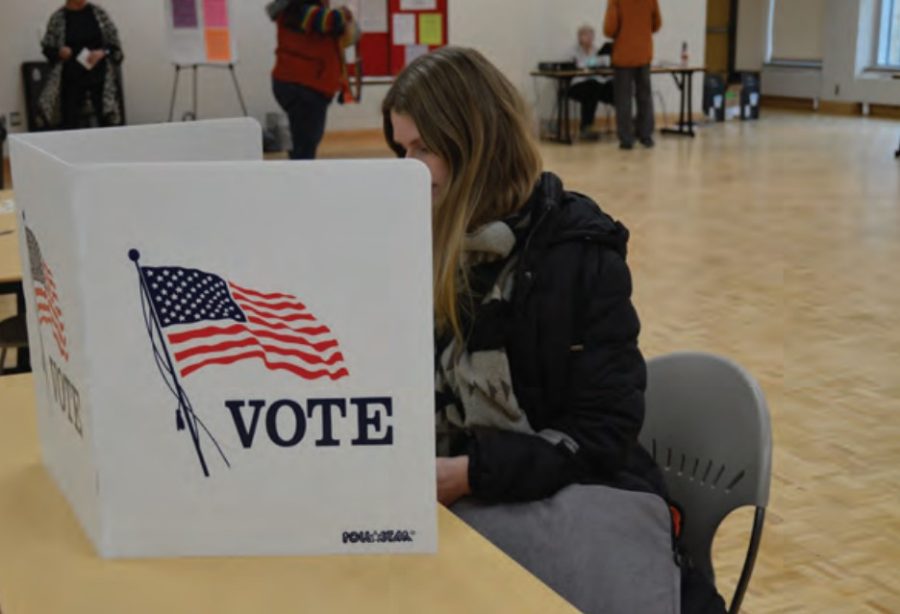Abortion rights, gerrymandering spark record-high voter turnout
Advance-Titan File Photo – Reeve Union was one of the many locations to vote at in Oshkosh on election day. Students can get Voter ID’s at Titan Central.
April 12, 2023
Wisconsin’s Supreme Court election on April 4 broke the record for highest voter turnout in a spring election that doesn’t coincide with a presidential election.
“Last week’s election was literally history-making for Wisconsin,” UW Oshkosh Center for Civic and Community Engagement (CCCE) intern Chloe Strand said. “This election would determine the partisan tilt.”
The race was won by Democrat-backed candidate Janet Protasiewicz over Republican-backed candidate and former Wisconsin Justice Dan Kelly, who lost the same election in 2020.
Voter turnout had already surpassed 36% by the end of Election Day, beating the previous record of 34% turnout for the 2011 midterm judicial election.
The $40 million price tag on the election made it the most expensive state judicial race in U.S. history while issues like reproductive care and gerrymandering divided voters.
Although the Court is technically non-partisan, most candidates’ ideology aligns with either one party or another, and the results gave the Wisconsin Supreme Court a 4-3 liberal-leaning majority.
UWO Political Science Associate Professor and Chair James Krueger said the partisan split may have driven more people to vote than in past judicial elections.
“Going into this election was a split 3-3 among conservatives and liberals,” he said. “So, the election was particularly important because the winning candidate would create a court majority.”
He said that candidates who identify with either the Republican or Democratic parties tend to draw more voters to polling centers.
“While the election was officially nonpartisan, both candidates demonstrated their connection to specific parties,” he said. “When candidates have connections to parties, it can drive more voters to the polls.”
Another factor that drove voter turnout was abortion rights, especially among younger voters, Strand said.
“Women’s reproductive rights was a key factor for this race, which I think brought a lot of people, especially younger progressives, to the polls,” she said. “I think what really made this election different was the stakes that were on the line for women.”
Protasiewicz was an open advocate for getting rid of Wisconsin’s abortion ban during her campaign and was endorsed by Planned Parenthood and Emily’s List, while Kelly was endorsed by Wisconsin Right to Life.
Strand said another factor in young-voter turnout was the strong voting advocacy around campus.
“I think what affected the student voting numbers were the signs posted everywhere, the continuous media pressure from College Dems, College Republicans, CCCE and public talk of what mattered on the ballot,” she said.
CCCE director Mike Lueder said another reason for increased voter turnout at UWO is the university’s decision to move its polling site back to Reeve Union Memorial after a temporary set up at the Culver Center.
“Having a polling location in Reeve is great for the students who live on campus,” he said. “I hope students recognize how convenient it is to vote here and take advantage of the opportunity.”
Poll workers in Reeve reported some of the highest student-voter turnout they’ve seen, Lueder said.
“[The Reeve poll workers] did say this was the most college students they have seen for a spring election,” he said.
Looking forward, Wisconsinites should be prepared to see more cases looking for a liberal-leaning decision, Krueger said.
“We should expect that more left-leaning organizations will try to bring cases before the Court while the majority holds just as more right-leaning organizations did under the conservative majority,” he said.
Krueger said students will be most affected by the key discussion topics of the race, including reproductive care and voting rights.
“The impact specifically on students is likely to be on the two issues currently in the spotlight: gerrymandering and abortion,” he said.
Lueder said he hopes that students will continue to participate in elections.
“I really hope this engagement continues,” he said. “Students are members of this community, and we rely on their voices in shaping the future of Oshkosh and Wisconsin.”














